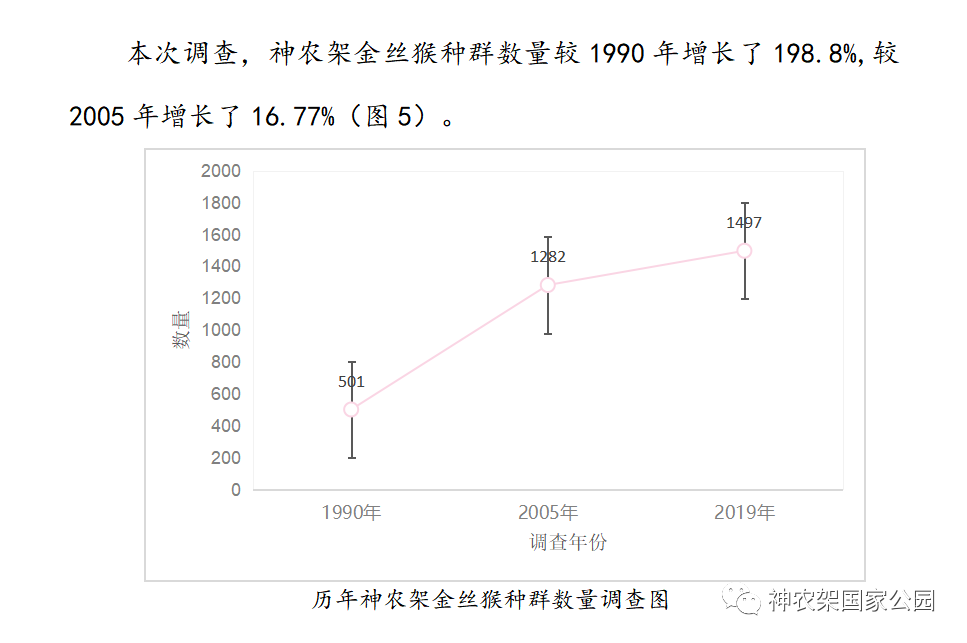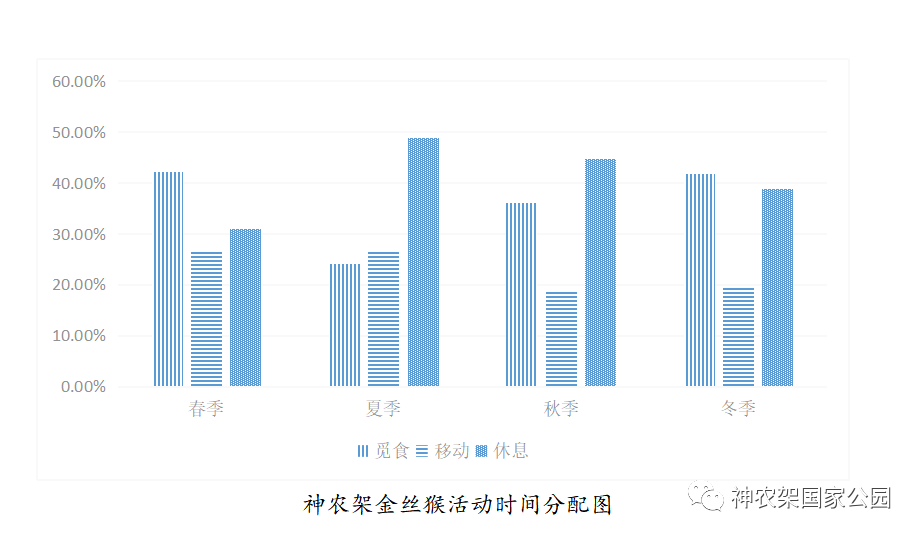The conservation and research process of the Golden Snub-nosed Monkey in Shennongjia
Updated:2022-10-17 Source:Shennongjia National Park
In 1978, a research team on unidentified animals in northwest Hubei collected 2 Golden Snub-nosed Monkey specimens in Shennongjia.
In 1979, the Shennongjia Golden Snub-nosed Monkey was identified by academia.
In 1980, Liu Minzhuang of East China Normal University first reported the distribution of Golden Snub-nosed Monkey in Shennongjia.
In 1986, Shennongjia National Nature Reserve conducted a preliminary survey on the number and distribution of Shennongjia Golden Snub-nosed Monkey with Professor Yang Qiren, Department of Biology of Central China Normal University. This survey started the academic research on this species.
From October 1989 to May 1990, Zhu Zhaoquan, He Degui and others in Shennongjia National Nature Reserve cooperated with Professor Yang Qiren of Central China Normal University to track and count the monkeys in the field to study the population, quantity, distribution, and the population structure of Shennongjia Golden Snub-nosed Monkey. It was reported that there were 2 groups of monkeys, totaling 501, in Shennongjia, their habitat covering an area of 85 square kilometers with a distribution density of 3.53 monkeys/square kilometer.
In 1995, Shennongjia National Nature Reserve started to cooperate with researcher Li Yiming and Dr. Liu Xuecong of the Institute of Zoology of the Chinese Academy of Sciences on research projects on the wild viability and habitat needs of the Golden Snub-nosed Monkey in Shennongjia. The cooperative research is still continuing up to the present.
In 1996, Shennongjia National Nature Reserve carried out cooperative research on Golden Snub-nosed Monkey together with Ren Renmei, Su Yanjie, Yan Kanghui and other researchers from the Department of Psychology of Peking University. They conducted research on the social behavior and behavioral ecology of Golden Snub-nosed Monkey, which they put into the book Society of Shennongjia Golden Snub-nosed Monkey in 2005.
In 1998, with the support of a GEF project, Shennongjia National Nature Reserve conducted a survey on the Golden Snub-nosed Monkeys and figured out that their population was 780.
In 2005, Shennongjia National Nature Reserve established the Golden Snub-nosed Monkey Conservation and Research Center, by which they established a research platform to conduct population surveys, artificial feeding experiments, and so on.
From April 2005 to April 2006, Shennongjia National Nature Reserve conducted a comprehensive survey on the distribution and population of Shennongjia Golden Snub-nosed Monkey. According to preliminary statistics, there were three large groups of Golden Snub-nosed Monkeys in Shennongjia National Nature Reserve, namely, Jinhouling Group, Dalongtan Group and Qianjiaping group, and also 8 small groups with a total of 1,282 monkeys. They were distributed in mixed coniferous and broad-leaved forests and coniferous forests between 1,600 and 3,000 meters above sea level, in a distribution area of 210 square kilometers and at a distribution density of 6.18 monkeys per square kilometer.
Since 2006, Shennongjia National Nature Reserve has cooperated with professors Zhang Zhixiang and Bao Weidong of Beijing Forestry University to carry out research on the habitat and behavior of Shennongjia Golden Snub-nosed Monkey.
In 2007, Dalongtan Research Center took full advantage of the platform to carry out research on the population ecology, habitat evaluation and artificially assisted breeding of Golden Snub-nosed Monkey with many domestic and foreign scientific research institutions, and established field monitoring station and observation plank road in Guanyindong and Qianjiaping. It also established the Golden Snub-nosed Monkey video monitoring system and display center, improved the Golden Snub-nosed Monkey artificially assisted breeding center. What’s more, they built a winter food supply base for the Golden Snub-nosed Monkey and launched the Guanmenshan Wildlife Rescue Center.
In December 2007, with the approval of the Hubei Provincial People's Government, the Department of Science and Technology of Hubei Province approved the establishment of Hubei Provincial Golden Snub-nosed Monkey Protection and Research Center.
In 2008, Shennongjia National Nature Reserve cooperated with the Chinese Academy of Forestry to carry out research on the plant community, associated animals and conservation genetics based on molecular biology in the Golden Snub-nosed Monkey’s habitat.
In 2009, Shennongjia National Nature Reserve cooperated with Central South University of Forestry and Technology to study the disease and reproductive behavior of Golden Snub-nosed Monkey.
In 2011, the National Forestry Administration (Shennongjia) Golden Snub-nosed Monkey Research Base was established.
In December 2011, Hubei Provincial Department of Science and Technology approved the establishment of Shennongjia Provincial Key Laboratory on Conservation Biology of Golden Snub-nosed Monkey, covering the fields of conservation genetics and conservation biology of Golden Snub-nosed Monkey.
On February 23, 2012, the National Forestry Administration approved the establishment of the National Forestry Administration (Shennongjia) Golden Snub-nosed Monkey Research Base, which was the first institution established in China to specialize in the study of Golden Snub-nosed Monkey.
From June 20, 2018 to June 20, 2019, the Scientific Research Institute of Shennongjia National Park conducted the third Golden Snub-nosed Monkey survey, finding 10 populations, altogether more than 1,470 monkeys, in Shennongjia. They were mainly distributed in mixed coniferous and broad-leaved forests in places like Daqianjiaping, Xiaoqianjiaping, Dashennongjia, Xiaoshennongjia, Jinhouling, Dalongtan, Luoquantao and so on at an altitude of 1,680-3,000 meters, their habitat covering an area of 350 square kilometers.
Since 2018, based on the advantages in natural resources and long-term accumulation in scientific research, the Scientific Research Institute of Shennongjia National Park has made a breakthrough in building the provincial scientific research and innovation platform in Shennongjia Forestry District from scratch. The National Forestry Administration (Shennongjia) Golden Snub-nosed Monkey Research Base was established, so were provincial and ministerial scientific research platforms such as the provincial key laboratory and the field observation station. The provincial key laboratory in Shennongjia was rated as excellent, ranking 29 out of 148 evaluations in 2018. The field observation station was also rated as excellent, ranking in the top 6 in the evaluation of 50 observation stations in 2020 and 2021.
In 2019, Shennongjia National Park was approved as a "National Nature Education Base".
In 2021, Shennongjia National Park cooperated with the Chinese Academy of Forestry and other units to jointly apply and became one of the council members of the Biodiversity Conservation Innovation Alliance of the National Forestry and Grassland Administration, which set a solid foundation for the comprehensive scientific research on the biodiversity conservation in Shennongjia. It has successively established a long-term cooperation model with more than 30 universities and scientific research institutions including the Chinese Academy of Sciences and Huazhong Agricultural University, enabling the provincial key laboratory and field observation station to realize the operation mechanism of resource sharing, open cooperation and coordinated development.
In 2021, Shennongjia National Park was approved as a National Forestry and Grassland Science Popularization Base.
 (LT18 team is observing the Golden Snub-nosed Monkeys on the opposite hillside)
(LT18 team is observing the Golden Snub-nosed Monkeys on the opposite hillside)




Copyright Shennongjia National Park
Address:36 Chulin Road, Muyu Town, Shennongjia Forestry District, Hubei Province 鄂ICP备18005077号-3
Address:36 Chulin Road, Muyu Town, Shennongjia Forestry District, Hubei Province 鄂ICP备18005077号-3
Email:2673990569@qq.com
Phone:0719-3453368
Phone:0719-3453368


TOP

